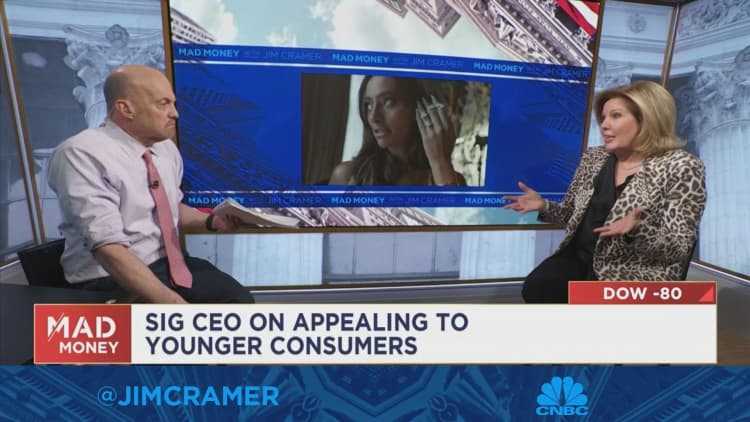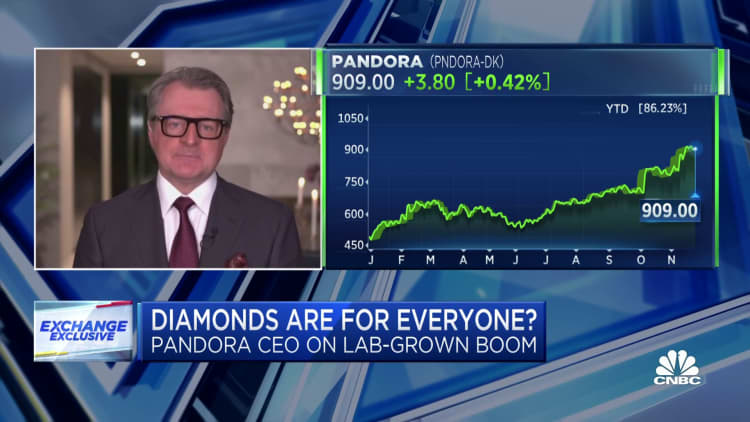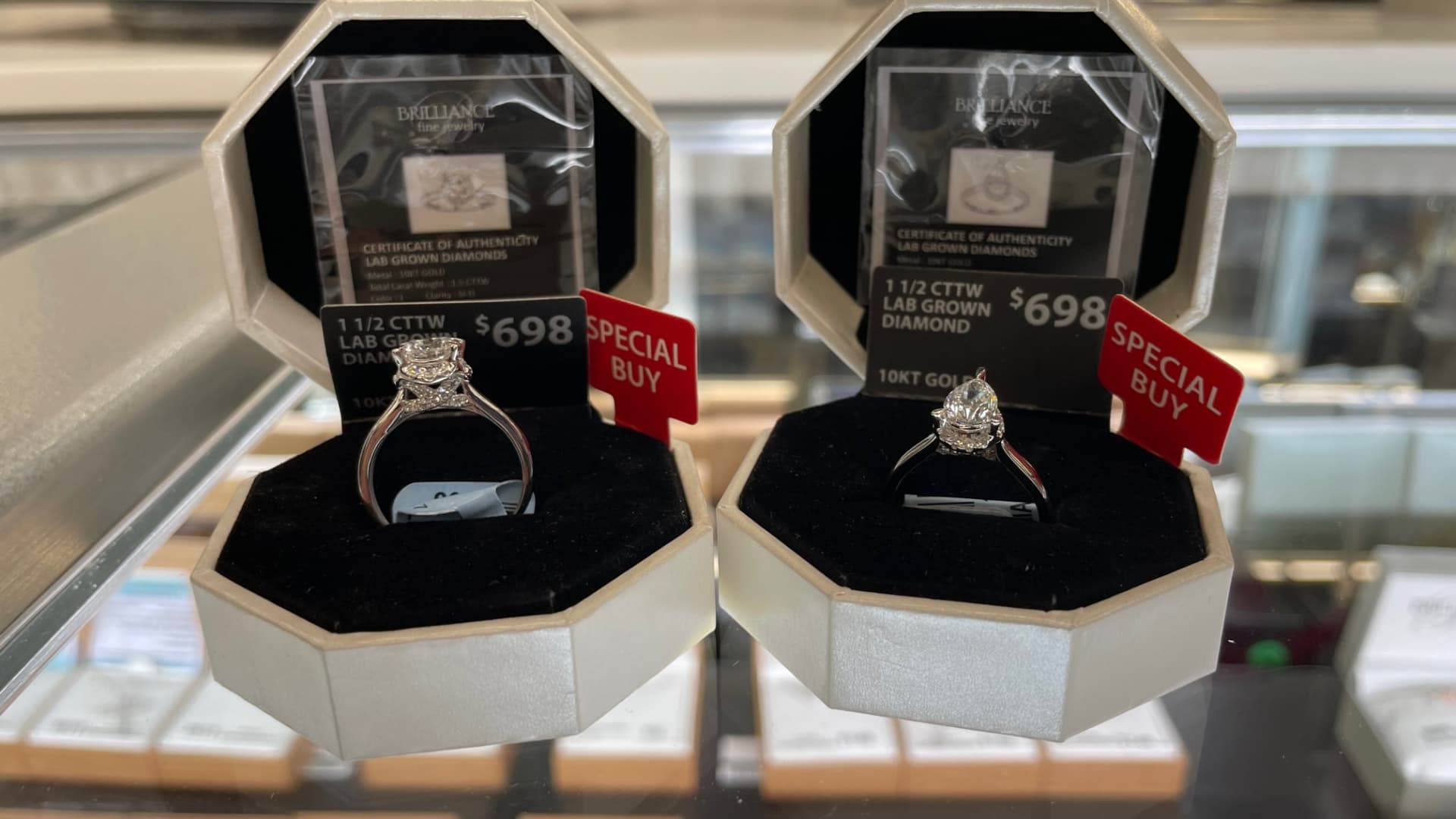Walmart started carrying lab-grown diamonds last year in select stores. Now, it has expanded that to nearly 90 items that range from $78 to $498 available at the majority of its stores.
Mike Calia | CNBC
SECAUCUS, N.J. — Here, shoppers can browse engagement rings, tennis bracelets and pendant necklaces displayed behind glass. Then, they can walk a few yards to grab milk, cereal or socks.
Welcome to Walmart.
During recent inflation, the world’s largest retailer attracted new and higher-income shoppers with cheaper groceries. Now, it’s trying to cater to that shopper with more fine jewelry at lower price points.
Ahead of the holiday season, the company introduced more styles of lab-grown diamond jewelry. It just started to test its largest lab-grown diamond offering yet — a 1.5 carat engagement ring that retails for $698. A mined diamond of that size can sell for a retail price of $6,000, said Walmart, which cited industry data and the typical markup.
Global sales for lab-grown diamonds grew to nearly $12 billion in 2022, a 38% year-over-year jump, according to an analysis by New York-based Paul Zimnisky, a financial and diamond industry analyst. That’s a sharp increase from under $1 billion in 2016, the analysis found.
The rise of lab-grown diamonds — which are made by people rather than mined from the ground — have made it possible for Walmart to carry a wider range of items that fit customers’ budgets, said Michelle Gill, the company’s vice president of jewelry and accessories.
And, she added, the company wants to test other statement pieces and bigger stones.
Walmart isn’t the only company looking for ways to serve shoppers seeking affordable jewelry. Signet Jewelers-owned chain Jared is testing a new product: a 24-karat gold ingot that is set in a charm and can be personalized, and then can be worn on a necklace or locked in a safe. The charm, which comes in different weights, arrived to about 60 of its stores ahead of the holiday shopping season.
Signet Jewelers-owned Jared started selling ingot charms at select stores. The circular or rectangular charms are made of pure gold and can be personalized.
Jared
So far, the charms have been a hit, said Claudia Cividino, president of Jared. Customers can personalize them or even inscribe them with a message in the gift-givers’ handwriting.
In times of uncertainty, people “look for stability,” she said. “Gold has always been a stored value. There’s something in the zeitgeist around gold and its properties.”
A high-stakes holiday season
Jewelry is a popular gift during the holidays. The period from October through February, including Valentine’s Day, is also the peak time for engagement ring purchases, Signet CEO Gina Drosos said in early December on an earnings call. Signet also owns Kay Jewelers, Zales and Diamonds Direct.
It could be tougher this season, though. Jewelry sales rose as consumers had extra money to spend on luxury goods during the pandemic and then sprang for extra sparkle as they booked vacations and went to parties. Social distancing during Covid also dampened the dating scene, which has translated to slower sales of engagement rings three or four years later. Signet and Brilliant Earth, a direct-to-consumer jewelry company, both cited this challenge on earnings calls.
Total jewelry sales were $73.08 billion in the U.S. in 2019, according to Euromonitor, a London-based market research company that tracks sales across a variety of retailers. That total is expected to hit $73.8 billion in 2023, Euromonitor estimates.

Fine jewelry has held up better than costume jewelry, however, though both have declined year over year. Sales in the fine jewelry category are expected to grow by nearly 4% compared with pre-pandemic 2019 to a total $62.85 billion in the U.S., according to Euromonitor. Costume jewelry is expected to drop by about 12% to $10.95 billion during the same period.
More sparkle for less
Walmart has carried jewelry since the 1990s, but it’s made a bigger play recently. It started carrying lab-grown diamonds last year in select stores. Now, it has expanded that to nearly 90 items that range from $78 to $498 available at the majority of its stores. In the past, many of Walmart’s items were made from a cluster of diamonds arranged to look like a single diamond, since mined diamonds cost much more, Gill said.
Gill, who worked for more than two decades at high-end department store chain Neiman Marcus, said Walmart also saw an opportunity to sell more fine jewelry, particularly in rural markets and parts of the U.S. dotted with struggling and shuttered malls.
Ahead of the holiday season, Walmart introduced its largest diamond yet — a 1.5 carat lab-grown diamond engagement ring that retails for $698.
Mike Calia | CNBC
Walmart does not break out category revenue, but it said lab-grown diamond sales have increased approximately 600% year over year. That reflects the addition of many more items to the category.
Yet for some shoppers, the idea of buying an engagement ring, anniversary present or other special purchase from the no-frills discounter is out of the question.
Gill acknowledged that Walmart will have to overcome that stigma. The retailer has had a similar uphill climb when trying to establish a reputation for carrying more stylish clothing by developing exclusive brands and teaming up with designers and celebrities. Plus, its stores don’t have dedicated jewelry specialists — something that Gill would like to change.
She said fine jewelry sold by Walmart comes in an elegant wooden box that isn’t marked with the Walmart name or logo.

“We’re elevating our experience in fashion,” she said. “We’ll continue to elevate our experience in fine jewelry.”
Yet she said younger shoppers, especially Gen Z, care less about brand and more about having the style or price they want. She saw that when her daughter, who is 22, recently got engaged and decided on a ring with a lab-grown emerald and lab-grown diamonds.
“This age group, they also love to go thrifting and they like to do secondhand and they rent their clothes online, so they can have new whether it’s for sustainability reasons or whether it’s for ‘I can do more with less,'” she said.
A new golden age
Other retailers, including Pandora and Brilliant Earth, have capitalized on the growth of lab-grown diamonds, too. Pandora introduced lab-grown diamond jewelry in the U.S. after it stopped using mined diamonds in 2021. The company has a growing presence inside Macy’s stores and on the department store’s website.
Brilliant Earth CEO Beth Gerstein said the company serves a different customer base than Walmart or Costco, which saw hot demand when it sold gold bars this fall, selling more than $100 million of them in the last quarter.
Gerstein said the direct-to-consumer jewelry company’s core shoppers are between age 25 and 40, have a household income of $75,000 or more, and tend to be more brand-focused.
Yet she said Brilliant Earth is offering prices and unique designs for shoppers on a budget this holiday season, along with those who are more willing to splurge. For example, she said, it introduced a lab-diamond bezel solitaire pendant necklace that costs less than $500.
She said the company’s holiday giveaways have drawn a stronger-than-usual response this year, too, as shoppers crave freebies. “The customer is looking for value wherever they can find it,” she said.
At Jared, Cividino said the average value of customers’ orders has risen slightly year over year, despite higher costs of many everyday expenses. Yet she said the jeweler has noticed customers visiting more or waiting longer before making a big purchase.
“People think harder before they make a decision,” she said. “That’s what we’re experiencing.”

